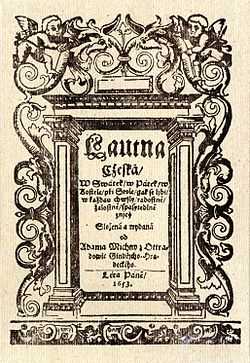Czech Lute

The Czech Lute (in Czech: Loutna česká) is a classical piece written by the Czech composer, Adam Michna z Otradovic. It is one of the early examples of the Czech Baroque music, originating from the seventeenth century (more accurately, from 1653). The whole piece is made up of 13 parts describing specific stories.[1] The first one is called "Foreword" and it is about a marriage between a man and a woman. The following texts talk about historical stories, for example the fate of Paris and Troy or the story of Jesus and Mother Mary.[2]
This collection of songs was composed for one alto, one soprano and two tenors, but it can be sung by larger choirs. Adam Michna himself is considered to be one of the most important Czech composers of the Baroque period[3] and the Czech Lute is thought to be the peak of his career along with the Songs for Mother Mary. The ninth part, Anjelské Přátelství has become one of the most popular songs from Adam Michna. The first five verses (Nebeští Kavalérové) are played on Malostranské Náměstí in Prague every hour by a trumpeteer.
Structure
- I. Předmluva.
- II. Povolání Duchovné Nevěsty. Dialogus.
- III. Matka Boží slavná Nadaní.
- IV. Svadební Prstýnek.
- V. Panenská Láska.
- VI. Žehnání s Světem.
- VII. Duchovní Svádební Lázeň. Díl První/Díl Druhý.
- VIII. Dušivěno. (+Díl Druhý)
- IX. Anjelské Přátelství.
- X. Svádební Věneček.
- XI. Den Svádební.
- XII. Domácí Vojna mezi Duši a Tělem.
- XIII. Smutek bláznivých Panen.
Score
- Michna z Otradovic, Adam; Pospíšil, Michael (ed.) (1998). Loutna Česká (in Czech). Brno: Collegium pro arte antiqua. (canto, organo, violini, basso)
References
- ↑ Michna, Adam z Otradovic. "Adam Michna - Loutna česká". CAS. Retrieved 26 March 2012.
- ↑ z Otradovic, Adam Michna. "Loutna česká". nostalghia. Retrieved 26 March 2012.
- ↑ Smolka, Jaroslav (2005). Hudba českého baroka (in Czech). Prague: Akademie múzických umění v Praze. p. 14. ISBN 80-7331-022-8.